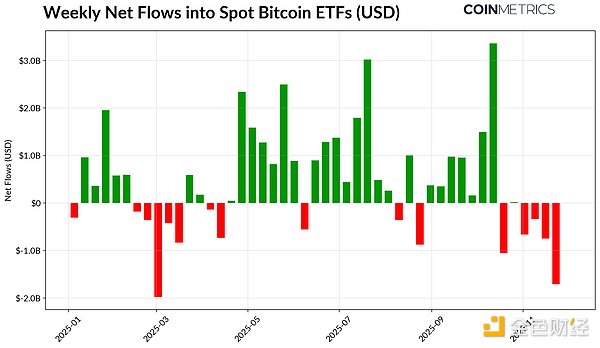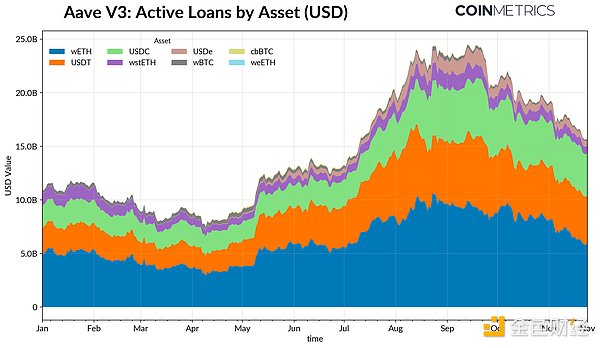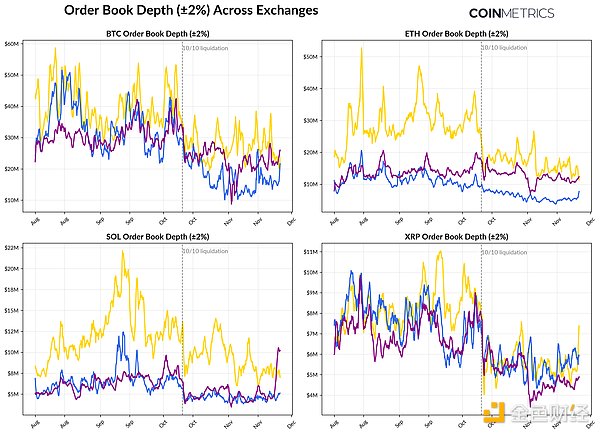Source: Coin Metrics
Written by: Tanay Ved,
Translated by: Shaw Jinse Finance
Key Points Summary
Recently, demand from major absorption channels such as ETFs and DAT has weakened, while October's deleveraging and ongoing macro-level risk aversion continue to put pressure on the digital asset market.
The leverage in the futures and DeFi lending markets has been reset, clarifying positions and reducing systemic risk.
The spot liquidity of mainstream coins and altcoins has not yet recovered, leaving the market still fragile and more susceptible to significant price fluctuations.
Introduction
"Uptober" started strong, with Bitcoin climbing to an all-time high. However, the flash crash in October quickly dampened market sentiment, leading to a decline in optimism. Since then, Bitcoin's price has dropped by about $40,000 (over 33%), and altcoins have also been severely impacted, causing the total market capitalization of cryptocurrencies to shrink to nearly $3 trillion. Despite good fundamental developments over the past year, there has been a significant divergence between price trends and market sentiment.
Digital assets seem to be at the intersection of various external and internal factors. On the macro front, the uncertainty of interest rate cuts in December and the recent weakness in tech stocks have intensified the market's risk aversion. In the cryptocurrency space, demand channels such as exchange-traded funds (ETFs) and digital asset trusts (DAT), which previously played a stabilizing role, are now experiencing capital outflows and pressure on cost bases. Meanwhile, the wave of deleveraging triggered on October 10 continues to have an impact, with market liquidity still insufficient.
In this article, we will delve into the driving factors behind the recent weakness in the digital asset market. We will focus on ETF fund flows, the leverage situation in perpetual futures and decentralized finance (DeFi) markets, and order book liquidity to explore the implications of these changes for the current market landscape.
Macroeconomic Environment Shifts to Risk Aversion
Bitcoin's performance is increasingly diverging from mainstream asset classes. Gold has surged amid record central bank purchases and ongoing trade tensions, with a year-to-date return exceeding 50%, while tech stocks (Nasdaq index) have lost momentum in the fourth quarter as the market reassesses the likelihood of imminent interest rate cuts and the sustainability of AI-driven valuations.
As emphasized in our previous research, Bitcoin typically exhibits a fluctuating relationship between "risk-on" tech stocks and "safe-haven" gold, which changes with the current macro environment. This makes Bitcoin particularly sensitive to market shocks or catalysts, such as the flash crash in October and the recent risk aversion.

Source: Coin Metrics Reference Rates & Google Finance
As Bitcoin serves as a barometer for the entire cryptocurrency market, its price decline has affected other assets. Although thematic sectors such as privacy briefly outperformed, these assets remain closely correlated with Bitcoin's movements.
Weakened Absorption Capacity of ETFs and DAT
Part of Bitcoin's recent weakness is due to a decline in the demand channels that supported its price strength for most of 2024 and 2025. Since mid-October, ETFs have seen net outflows for several consecutive weeks, totaling $4.9 billion. This is the largest redemption wave since Bitcoin fell to around $75,000 in April 2025 (before the "Liberation Day" tariff announcement). Despite the short-term capital outflows, on-chain holdings continue to rise, with BlackRock's IBIT ETF holding 780,000 Bitcoins, accounting for about 60% of the current total supply of spot Bitcoin ETFs.
If capital continues to flow back in, it would indicate that this channel is stabilizing, as historically, ETF demand has been a significant absorption force when risk appetite improves.

Source: Coin Metrics Network Data Pro
DAT is also beginning to show pressure. As prices have retreated, the value of its shares and cryptocurrency holdings has shrunk, squeezing the net asset value premium that supports its growth. This has reduced their ability to finance through equity or debt issuance, thereby limiting the growth of their per-share cryptocurrency holdings. Smaller and newer DATs are particularly susceptible to this dynamic, as changes in market conditions can lead to unfavorable cost bases and stock valuations for further accumulation.
Strategy is currently the largest Bitcoin DAT holder, with 649,870 Bitcoins (about 3.2% of the current Bitcoin supply) and an average purchase cost of $74,333. As shown in the chart below, when Bitcoin's price rises and its asset valuation is strong, Strategy's purchasing speed significantly increases, while it has recently slowed down, not due to active selling. Nevertheless, Strategy still holds unrealized gains, with its cost basis below the current market price.
Although Strategy may face pressure if prices decline further or if there is a potential risk of index removal, a reversal in market conditions could enhance balance sheet strength and valuation, restoring an environment conducive to more aggressive accumulation by DATs.

Source: Strategy & Bitbo Treasuries
This seems to align with on-chain profit trends. The realized profit-loss ratio (SOPR) for short-term holders (holding period less than 155 days) has dropped to about 23% loss level, which historically reflects surrender pressure from the most price-sensitive group. Long-term holders remain in profit on average, but SOPR shows a slight rebound in distribution, indicating selective profit-taking. If the SOPR for short-term holders rebounds above 1.0 while the distribution of long-term holders slows down, it would indicate that the market is stabilizing.
Deleveraging in Cryptocurrency: Perpetual Contracts, DeFi Lending, and Liquidity
The wave of liquidations on October 10 marked the beginning of a multi-layered deleveraging cycle in the futures contracts, DeFi, and stablecoin-supported leverage sectors, the effects of which continue to reverberate in the cryptocurrency market.
Ongoing Liquidations
In just a few hours, perpetual contracts faced the largest forced liquidations in history, wiping out over 30% of the open interest accumulated over months. The decline in open interest was most pronounced in altcoin and retail trading venues such as Hyperliquid, Binance, and Bybit, where leverage had surged prior to the event. As shown in the chart below, open interest remains well below the pre-crash high of over $90 billion and has slightly decreased since then. This indicates that as the market stabilizes and readjusts, leverage in the system is receding.
During this period, funding rates have also declined, reflecting an adjustment in bullish risk appetite. Bitcoin's funding rate has recently hovered around neutral or slightly negative, consistent with the market's incomplete reconstruction of directional confidence.

Source: Coin Metrics Market Data Pro
DeFi Deleveraging
The DeFi lending market has also undergone a gradual deleveraging phase. Since peaking in late September, the number of active loans on the Aave V3 platform has been on a downward trend, as borrowers have reduced leverage and repaid debts amid weakened risk appetite and collateral repricing. The decline in borrowing denominated in stablecoins has been particularly pronounced, with the depegging of Ethena USDe exacerbating this trend, leading to a 65% drop in USDe borrowing and triggering broader deleveraging of synthetic dollars.
Ethereum-based lending has also contracted, with loans of wrapped Ethereum (WETH) and liquid staking tokens (LST) decreasing by about 35%-40%, indicating reduced arbitrage activity and a scaling back of yield collateral strategies.

Source: Coin Metrics ATLAS
Shallow Spot Market Liquidity
After the liquidation wave on October 10, spot market liquidity remains weak. Across major exchanges, the bid-ask spreads (±2%) for Bitcoin, Ethereum, and Solana are still 30%-40% lower than levels at the beginning of October, indicating that liquidity has not recovered alongside prices. With fewer orders, the market is more fragile, and even a small amount of trading activity can lead to significant price fluctuations, exacerbating market volatility and amplifying the effects of forced selling.
The liquidity situation for altcoins is even weaker. Aside from mainstream coins, the order book depth for other cryptocurrencies has decreased more significantly and for a longer duration, reflecting ongoing risk aversion among market participants and reduced market-making activity for mainstream coins and altcoins. A comprehensive improvement in spot market liquidity would help reduce price shocks and stabilize market conditions, but for now, order book depth remains one of the most evident signs of ongoing pressure in the system.

Source: Coin Metrics Market Data Pro
Conclusion
The digital asset market is undergoing a broad adjustment, primarily influenced by weakened demand from ETFs and DAT, the resetting of leverage in futures contracts and DeFi, and insufficient spot liquidity. These factors are putting pressure on prices but are also making the entire system healthier, with lower leverage, more neutral positions, and increasing support from fundamentals.
At the same time, the macroeconomic environment continues to pose adverse factors: weakness in AI stocks, changes in interest rate cut expectations, and widespread risk aversion are suppressing market demand. The continued recovery of major demand channels, such as ETF inflows, DAT accumulation, stablecoin supply growth, and a rebound in spot liquidity, will lay the foundation for market stabilization and eventual reversal. Until then, the market will remain influenced by the tension between macro risk aversion and the internal market structure of cryptocurrencies.
免责声明:本文章仅代表作者个人观点,不代表本平台的立场和观点。本文章仅供信息分享,不构成对任何人的任何投资建议。用户与作者之间的任何争议,与本平台无关。如网页中刊载的文章或图片涉及侵权,请提供相关的权利证明和身份证明发送邮件到support@aicoin.com,本平台相关工作人员将会进行核查。



